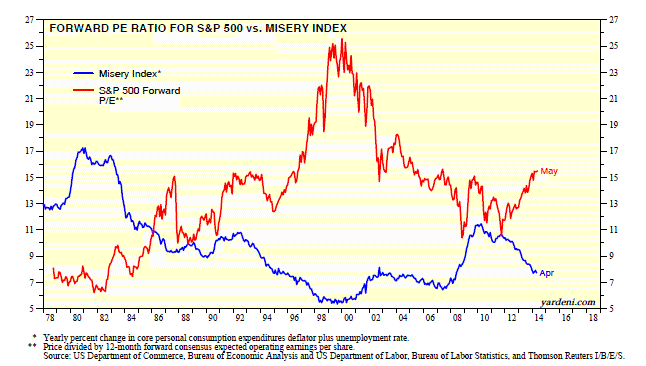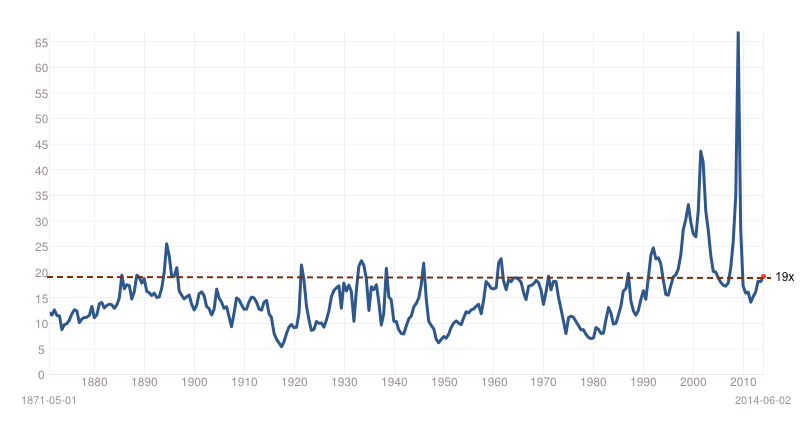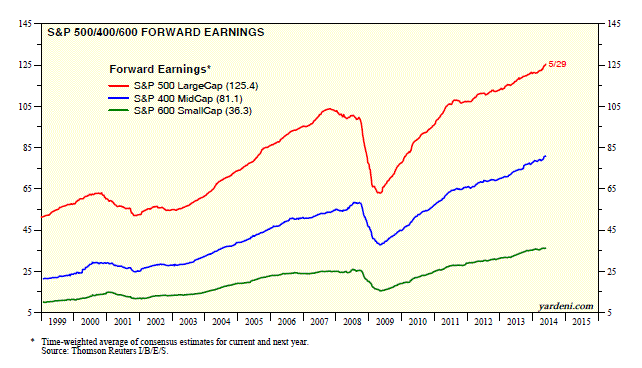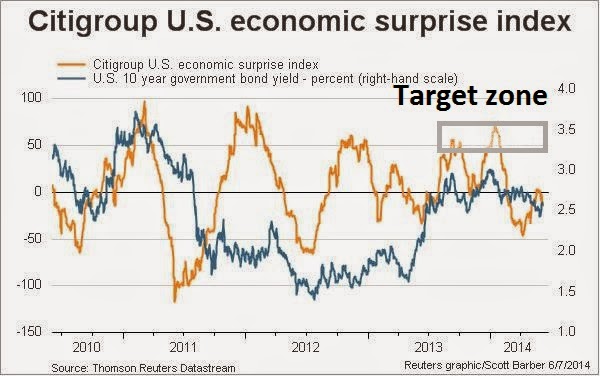As the major US equity averages move to new all-time highs, I continue to grapple with the question of whether stocks are cheap or expensive.
I had written that based on P/E, P/B and dividend yield metrics, US stock market valuations appeared to be elevated from a long-term viewpoint (see More evidence of a low equity return outlook). However, Ed Yardeni recently penned a piece of analysis indicating that P/E ratios could expand further because of a falling Misery Index because of their historical inverse correlation.
How can this be? If P/E ratios are already elevated relative to their long-term history, then higher stock prices would compress long-term expected returns even more. Is this possible? Is a bubble forming in US equities?
The long term picture
I continue to stand by my view, that of a low-return environment. Notwithstanding the analysis of so-called permabears like John Hussman, Bridgewater Associates gave a slightly different take on the question based on a global macro point of view and projected a 10-year US equity expected return of 3.6%—an astonishingly low rate.
To reinforce the low return thesis, The Fat Pitch indirectly argued against the Yardeni view of P/E expansion by noting that multiple expansion is unlikely to occur at these elevated P/E levels. In fact, the only occasions when P/E ratios have expanded when P/Es were this high was when the E fell, not because P rose:
Yet, it's generally assumed that P/Es go higher than 19x (into the 20s) during bull markets. A look at the chart below seems to confirm this.
That assumption is false. Leaving aside the late 1990s tech bubble, nearly every instance where P/Es exceeded current levels was started by a fall in earnings. In other words, earnings declined before the market knew it, pushing P/Es higher.
What bubble? We're having a Spring party!
How can stocks be overvalued and rise? What about Yardeni's Misery Index analysis?
I resolve this dilemma by differentiating between time horizons. Over the long-term, US equity valuations are stretched. Although I believe that Bridgewater`s 3.6% projected return is a tad on the low side, the point here is that long-term equity expected returns are low.
On the other hand, Yardeni is correct in that stock prices can continue to grind higher in the short and medium term as long as non-inflationary growth holds up. US Q1 GDP growth was negative because of poor weather and we have seen signs of a rapid recovery. Yardeni also showed that forward 12 month Street consensus estimates are continuing to rise across all market cap bands, which is supportive of higher equity prices:
Once again, the year-over-year growth rate of the forward estimate rose to 8.59% from last week’s 8.54%, for the seventh consecutive weekly increase.
For a slightly different perspective, Scott Grannis explained that he remains constructive on equity returns because there are few good alternatives:
PE ratios are now moving above their long-term average. The growth of corporate profits has slowed—earnings per share are up at only a 2.4% annualized rate in the past three months—even as PE multiples have increased. Investors are willing to pay more for a dollar of earnings because the earnings yield on equities (now about 5.5%) is significantly better than the yield on cash, and the risk of a recession is very low (negative real yields on cash plus a steep yield curve all but rule out a recession).
As New Deal Democrat aptly puts it in this week's review of high frequency economic releases, the growth outlook is positive and we are into the "Spring spring":
This week was boring, but in the best possible way, as the string of positive reports continues,and if anything was even stronger this week. The only significant negative remains mortgage applications. Almost everything else was positive...
GDP in the second quarter looks like it will come in very strong, and the rest of 2014 remains intact as well. We're cruisin' into Summer on our Spring spring.
Joe Wiesenthal confirmed New Deal Democrat's "Spring spring" thesis by pointing to signs of renewed credit expansion:
On Friday we got fresh data on bank lending and consumer credit. The below chart shows the year-over-year change in loans and leases from commercial banks (red line) and revolving consumer credit, AKA credit card usage, in the blue line.
What's clear is that both are on an upswing. Both measures made steady gains out of the slump, and then stalled out again. A new credit expansion would be crucial, as it would allow the economy to really gather steam, feeding on itself, and break out of the post-crisis slump.
Cheap or expensive?
To go back to the original question of whether US equities cheap or expensive, it's actually both.
Your view depends on the time horizon. Long-term expected returns aren't great. On the other hand, stock prices can move higher, as long as growth holds up. So watch for the turn in growth expectations.
Disclosure: Cam Hui is a portfolio manager at Qwest Investment Fund Management Ltd. (“Qwest”). The opinions and any recommendations expressed in the blog are those of the author and do not reflect the opinions and recommendations of Qwest. Qwest reviews Mr. Hui’s blog to ensure it is connected with Mr. Hui’s obligation to deal fairly, honestly and in good faith with the blog’s readers.”
None of the information or opinions expressed in this blog constitutes a solicitation for the purchase or sale of any security or other instrument. Nothing in this blog constitutes investment advice and any recommendations that may be contained herein have not been based upon a consideration of the investment objectives, financial situation or particular needs of any specific recipient. Any purchase or sale activity in any securities or other instrument should be based upon your own analysis and conclusions. Past performance is not indicative of future results. Either Qwest or I may hold or control long or short positions in the securities or instruments mentioned.







